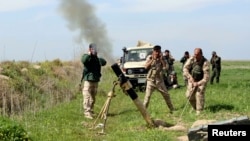In recent months, as the Islamic State (IS) militant group expanded its control in Syria and Iraq, the specter of the "IS threat" has dominated headlines in Central Asia, with reports that many hundreds, if not thousands, of men and women from the region have gone to join the militant group in the Middle East.
In Tajikistan, Central Asia's poorest state, "blowback" fears have been heightened by threats made by Tajik IS militants who have said they intend to shift their activities from the Middle East to their homeland.
Despite these threats, however, so far "nothing has materialized," says Edward Lemon, a doctoral candidate at the University of Exeter who tracks Tajik militants in Syria and Iraq.
Lemon, whose research examines the links between migration, religion, and security within Central Asian communities in Russia, is currently based in Moscow. He pointed out to RFE/RL that it is Russian commentators in particular who "have been vocal in hyping the Islamic State's threat to Central Asia" and that many of those who do so go on to argue that Russian troops should intervene to protect Moscow's interests in the region.
RFE/RL: A recent report by the International Crisis Group (ICG) suggested that between 2,000-4,000 men and women from five Central Asian states, including Tajikistan, have gone to Syria. Are you able to give your own estimate of how many Tajiks may have gone to join militant groups in Syria and Iraq?
Edward Lemon: Estimates from within Tajikistan vary. Where the Ministry of Internal Affairs has given a figure of 200, the State Security Committee says there are 300 Tajiks in Syria and Iraq. Based on my research, I have found online evidence for 70 fighters. But there are likely to be more who have traveled and whose existence has not been reported in the media. I think a figure of between 100 and 200 would be fairly accurate.
RFE/RL: I'd like to look at how and where Tajiks are being recruited into the Islamic State (IS) group and other militant factions in Syria and Iraq. For example, Tajikistan's Labor Minister claimed recently that 200 Tajik labor migrants had been radicalized in Russia and gone to Syria. Is this a credible claim, and are labor migrants particularly vulnerable to recruitment, or are Tajiks also being recruited inside Tajikistan?
Lemon: When we examine the profiles of Tajik IS fighters, it is evident that the majority of them spent time in Russia. With over 1 million Tajiks working in Russia, this is not surprising. According to media reports, many of these individuals did not display signs of piety before going to Russia. So it seems like many are being recruited in Russia. The dynamics by which they are recruited are yet to be researched in any depth.
RFE/RL: Have you been able to identify any particular profile of Tajik militants in Syria/Iraq? For example, are they particularly religious, do they tend to be less educated or poorer individuals?
Lemon: The profiles of Tajik militants vary. Some are educated, others not. For example, Abu Muhammed Al-Tajiki, aka Alan Chekhranov, attended the prestigious Tajik-Slavonic University in Dushanbe. Although many have come from rural areas, some were born in Dushanbe. Nevertheless, certain commonalities exist amongst the majority of militants. Most are young men; the oldest recorded militant was 41 years old. Most have spent time in Russia. The majority of them displayed few signs of piety or interest in religion growing up.
RFE/RL: What factions are Tajiks fighting with in Syria and Iraq? Are they mostly with IS or are there other Tajik factions as well?
Lemon: When reports of Tajiks fighting in Syria began to surface in 2013, many were fighting with [Al-Qaeda's Syrian affiliate, Jabhat] al-Nusra. But nowadays it seems the vast majority are fighting with IS in Syria and Iraq. Whilst we cannot be sure of exactly where they fit into IS's structure, videos posted on Russian social networking sites show Tajik militants living and fighting together.
RFE/RL: One phenomenon I have seen among militants from the former Soviet region -- particularly the North Caucasus and Uzbekistan -- is that alongside the young recruits there are a small number of experienced, "veteran" militants who have gone to Syria to fight, such as Muslim Shishani (Murad Margoshvili) from Pankisi. Have you identified any "veteran" militants among the Tajik fighters?
Lemon: Not to my knowledge. Most Tajik militants seem to be experiencing their first combat in Syria and Iraq. Many of the veteran "Islamic" militants, such as Ali Bedaki, Mirzo Ziyoyev, and Mullo Abdullo, who fought with the opposition during the civil war are now dead. The only "veteran" Tajik Islamist leader who has a public profile is the shadowy leader of Jamoat Ansruallah, Amriddin Tabarov, who is thought to be in Pakistan.
RFE/RL: There have been reports of Tajik militants in IS threatening to return home to wage jihad in Tajikistan. How credible are these threats, and the threat of "blowback" in general?
Lemon: It is impossible to objectively measure the threat posed by the Islamic State in Tajikistan. Most media produced by Tajik militants focuses on life in the Islamic State itself and calls on fellow Tajiks to join the jihad. Fewer videos are directed at religious issues in Tajikistan itself. Although, militants have threatened to attack the country on numerous occasions and thus far nothing has materialized. Syria and Iraq are a long way from Tajikistan. Russian commentators in particular have been vocal in hyping the Islamic State's threat to Central Asia. It is important to remember than Russian border guards patrolled the border with Afghanistan until 2005 and they maintain a base in the south of the country. Many of those who say that IS pose a threat, follow this up by saying Russian troops need to intervene to protect its interests there.
-- Joanna Paraszczuk
